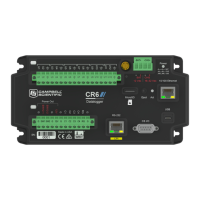9.9.3 Severing a ground loop
To avoid or eliminate ground loops, when they are detected, requires severing the loop.
Suggestions for severing ground loops include:
l Connect the shield wire of a signal cable to ground only at one end of the cable. Leave the
other end floating (not connected to ground).
l Never intentionally use the shield (or drain wire) of a cable as a signal ground or power
ground.
l Use the mechanical support structure only as a connection for the safety ground (usually
the ground lug). Do not intentionally return power ground through the structure.
l Do not use shielded Cat5e cables for Ethernet, CPI or EPI communications.
l For long distance communication protocols such as RS-485, RS-422, and CAN, use the RG
terminal for the ground connection. The RG terminal has a 100-ohm resistor in series with
ground to limit the amount of DC current than can flow between the two endpoints while
keeping the common-mode voltage in range of the transceivers. The transceivers
themselves have enhanced voltage range inputs allowing for ground voltage differences of
up to 7 V between endpoints.
l For exceptional cases, use optical or galvanic isolation devices to provide a signal
connection without any accompanying ground connection. These should be used only
when ground loops are causing system problems and the other methods of breaking a
ground loop don’t apply. These devices add expense and tend to consume large amounts
of power.
9.9.4 Soil moisture example
When measuring soil moisture with a resistance block, or water conductivity with a resistance
cell, the potential exists for a ground loop error. In the case of an ionic soil matric potential (soil
moisture) sensor, a ground loop arises because soil and water provide an alternate path for the
excitation to return to data logger ground. This example is modeled in the following image:
9. Tips and troubleshooting 145

